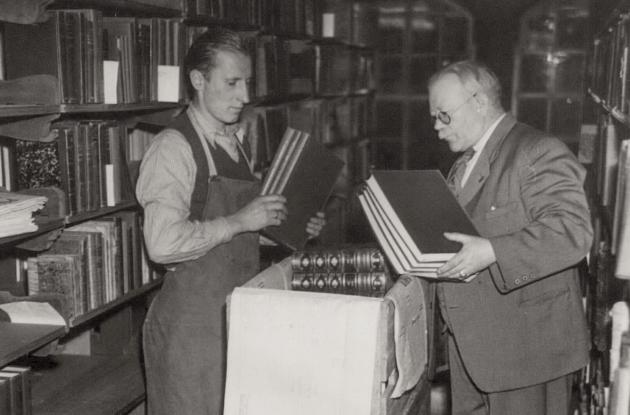The history of the collection of prints and photographs
In 1902, a large part of the library's stock of maps and images was gathered in one collection. Chief Librarian H.O. Lange was responsible for the merger.

Photo: Ophav ukendt
The new collection of images included Müllers picture gallery (acquired in 1796), the topographical collection, the Danish portrait collection (established in 1870) and the foreign portrait collection (established in 1892). These were procurements, transferred copies from the Royal Collection of Graphic Art and copperplates, which were collected on the basis of the new and comprehensive Legal Deposit Act introduced in 1781.
The collection grows in scope
Bjørn Ochsner, MA in Philosophy, became very important for the collection during the 20th century. He took over as head of the department in April 1944 and managed the collection until 1980. From the statement "Map and Image Collection 1944", which was probably prepared in connection with Ochsner's appointment, it appears that the collection at that time consisted of:
- 14,000 Danish and 10,000 foreign portraits in print
- 5,000 Danish and 3,000 foreign portraits in photography
- 4,000 Danish and 1,000 foreign historical magazines
- 16,000 Danish and 2,000 foreign topographical magazines
- 120,000 postcards
- Müller's picture gallery
- Frederik V's Atlas
- cards and more
Ochsner was an energetic leader who acquired many smaller collections of images through his outreach work:
- private donations from living persons as well as from estates of deceased persons
- photo archives
- Herdis and Herman Jacobsen
- Laurberg and Gad
- Johs. Hauerslev
- royal court photographer Peter Elfelt
- press photographer Holger Damgaard
- commercial photographer Sven Türck
- Hans Robertson
- Rie Nissen
- archives from daily newspapers, publishers etcetera
- Carl Allers Etablissement
- Gyldendals Forlag
- Stenders Kunstforlag
- Aftenbladet
- Dagens Nyheder
- large aerial photograph collections
In addition to the large individual acquisitions, the collection grew by approximately 50,000 magazines a year for a significant amount of time. In 1980, the collection consisted of more than three million units.
Under Ochsner, the library acquired famous photographs by internationally renowned photographers such as:
- Roger Fenton
- Julia Margaret Cameron
- Francis Frith
- Louis de Clercq
- Gustave Le Gray
- Francis Bedford
- Maxime Du Camp
- Henry Fox Talbot
He also purchased photographs of a documentary and artistic nature by prominent Danish photographers.
New sub-collections are added
In 1970, the sub-collection the photo-historical collection was created with a collection of examples of early positive techniques such as daguerreotypes, ambrotypes, vitrotypes, ferrotypes, pannotypes (ca. 1840 - ca. 1920), negative-positive processes such as calotypes, cyanotypes, albumen prints, collodion processes etc., photogravure, woodbury types (photoglypties), Albertypes as well as carte de visites and cabinet cards, photo albums, stereograms and stereoscopic devices, etcetera, and also photo-historical magazines with Danish and foreign photographers' works.
In 1981, the library and Københavns Bymuseum (now Museum of Copenhagen) bought royal court photographer Peter Elfelt's (1866-1931) archive with 400,000 photos of people and places in Copenhagen.
In 1989, the collection an aerial view of Denmark drastically increased when the library acquired Sylvest Jensen's collection. Today it has approximately 5,2 million units. The collection, which contains both negatives and positives, consists primarily of classic oblique photographs of farms and houses from the period 1936-1992. The collection also features a large number of vertical photographs that were originally produced for mapping or military purposes.
The photo-historical collection formed the basis for the national photo museum, which Bjørn Ochsner had already proposed the Minister of Culture establish in 1980. The National Museum of Photography got its name in 1996, and when The Black Diamond was completed in 1999, the museum moved into the current exhibition spaces.
Four years later, another museum opened with a collection under the collection of prints and photographs, namely the Museum of Danish Illustrators, which opened its doors in 2000.
In 2020, the National Photo Museum changed its name to The National Photo Collection and is still part of the prints and photographs collection under the library's special collections.
The Museum of Danish Illustrators was subsequently transferred to Den Gamle By in Aarhus. The library still has the majority of the digitised drawings in the collection..
The collection is still growing
We continue to collect physical images for the collection of prints and photographs through donations and procurements.
Important acquisitions from 2020 onwards
- works by Nanna Debois Buhl, Jeannette Ehlers, Fryd Frydendahl, Linda Hansen, Nicolai Howalt, Petra Kleis, Zanele Muholi, Emil Ryge, Peter Sekaer and Innuteq Storch for the National Photo Collection
- the archives after Aller, Dansk Byplanlaboratorium, Foreningen OOA and Jakob & Weiland Reklamefoto
- the archives of the photographers Lilian Bolvinkel, Tove Kurtzweill and Poul Raa
- a number of photo-historically interesting images such as stereo photographs, daguerreotypes, group photos and albums
Digital images are also collected. This is done primarily through netarkivet, which archives the Danish part of the Internet and thus a huge amount of images, along with an extensive part of the Danish visual cultural heritage today.
Read more about the history of the collection of prints and photographs
Berggreen, H. (1990). Bjørn Ochsner og Det kongelige Biblioteks Kort- og Billedafdeling. Fund Og Forskning I Det Kongelige Biblioteks Samlinger, 29 (1), 11.